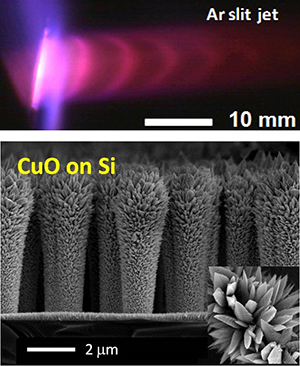
The Gordon lab is developing microplasma-based routes to create nanoparticles and hierarchically-ordered thin films and nanostructures which have interesting optical, electronic, and catalytic properties. They are currently studying the fundamental physics of these supersonic plasma jets and plasma-assisted growth process as well as using the resulting structured films for applications in magnetism, catalysis, and energy storage.
Segalman investigates nanostructured functional materials, including both polymerized ionic liquid and conjugated polymer containing block copolymers. These block copolymers form regular structures over nanometer length scales, and permit studies of the role of confinement on ionic and electrical transport. In addition, the group develops block copolymer platforms for discrete nanoscale doping of inorganic semiconductors.
In partnership with companies including Intel, Samsung Electronics and Dow Chemical, among others, Fredrickson has developed a theoretical platform and suite of software tools that is guiding the use of block copolymer assembly in advanced lithography to pattern microelectronic devices on 10 nm lengthscales.
Helgeson is developing nanoemulsions can be reversibly self-assembled into hierarchical structures, which can then be used as liquid templates for nanoparticles and porous solids with well-controlled properties for a wide range of material chemistries. For example, the group is using these materials to understand how porosity affects the mechanical, transport and stimuli-responsive properties of polymer hydrogels, eventually to design materials for chemical weapon protection.
The Christopher lab develops synthetic approaches for producing hybrid metal-metal oxide heterostructures with controlled geometries and compositions. Examples of nanostructured materials include Pt-group species deposited with site-specificity and controlled geometries (down to the limit of single atoms) onto very small (~5 nm diameter) oxide nanoparticles and core-shell heterostructures with controlled plamonic and catalytic functionalities.



